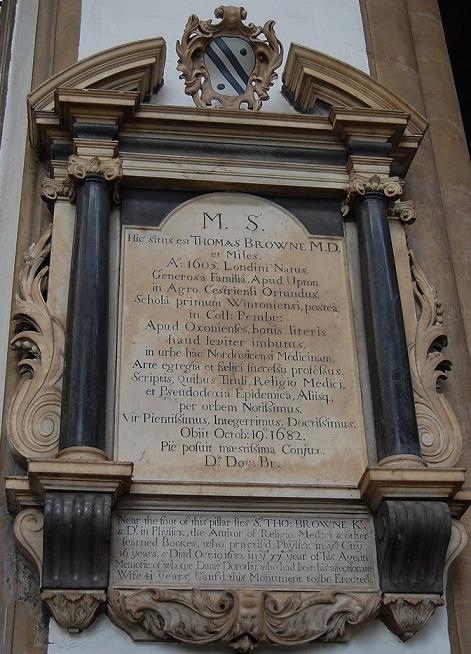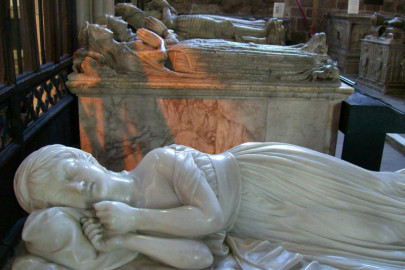Nige ponders the unusual movements of some writerly remains…
The photograph above depicts Sir Thomas Browne’s tomb in St Peter Mancroft, Norwich – his coffin is in the chancel of the church. It was accidentally opened in 1840, and some bright spark took the skull – theft of skulls was a common weakness of craniologically obsessed Victorians – and presented it to the museum of the Norfolk and Norwich Hospital, where it was on display for 80-odd years before being restored to its proper place (after casts had been taken).
Readers of W.G. Sebald’s The Rings Of Saturn [read Nige’s 1p Review here] will recall his meditations on the fate of Browne’s skull, and readers of Sir Thomas himself will recall that he wrote in his Hydriotaphia, or Urne Buriall:
‘Who knows the fate of his bones, or how often he is to be buried? Who hath the oracle of his ashes, or whither they are to be scattered?… To be gnawed out of our graves, to have our skulls made drinking bowls and our bones turned into pipes, to delight and sport our enemies, are tragical abominations.’
Still, the mortal remains of another great English writer – Laurence Sterne – suffered a worse fate than Browne’s. His body was exhumed from its resting place in the graveyard of St George’s, Hanover Square, sold to anatomists, and only rescued (to be reburied against the south wall of his own church, Coxwold in Yorkshire) when someone recognised his face (below). Saved by fame.













And what a fine, strong face is reflected in that mask Nige, with no sign of the consumption that killed him. Tried Tristram Shandy a few times, but struggled to get on with it. Your post prompts me to perhaps give it another go……
Yes, Sterne was a tough nut for all his posturing – and Tristram Shandy can be a tough nut to crack. You could try the Sentimental Journey? At least it’s a whole lot shorter…
Those pesky phrenologists!
The parson character in Tristram Shandy, who is partly an alter ego of Sterne himself, is called Yorick, a fact that is somewhat ironic as we look back at him through this story of Sterne’s disturbed bones. Alas indeed.
It was from his encountering a mould of the skull of Sir Thomas Browne at the old Norfolk and Norwich hospital that W.G. Sebald began to take an interest in Browne and to exercise by walking the Norfolk/Suffolk coast-line, resulting in the work ‘Rings of Saturn’.
Just as interesting as the fate of Browne’s skull if not more so, is Browne’s Coffin plate which has inscribed upon it something like – Amplissimus Vir Hic dormiens corporis spagyricci plumbum in aurum convertit, which unless your Latin is good , i shall supply a translation of for you if you so request !
Please do!
The Browne/Sterne/Yorick connection. Believe it or not I actually gave a brief lecture on this in a training session (on giving presentations) for work. I could almost accuse you all of reading my August blog post on the topic:
http://newpsalmanazar.wordpress.com/2011/08/17/the-eloquent-bones/
A note to Mahlerman: While ‘A Sentimental Journey’ is a fine book and worth Nige’s recommendation, I really think it’s a better dessert than appetizer for ‘Tristram Shandy.’
Great Virtues . Sleeping here his alchemical/spagyricci body converts from lead to gold.
More here –
http://munksroll.rcplondon.ac.uk/Biography/Details/617
But actually it’s a monument in memory of Browne, not his tomb. His tomb/coffin is marked as you state, nearby on the chancel floor. Can you imagine a lead coffin being hoisted and inserted half-way up a wall ? It’s a monument. His wife’s monument is on the opposite facing wall.